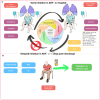Sodium-glucose Co-transporter 2 Inhibitors in Acute Heart Failure: A Review of the Available Evidence and Practical Guidance on Clinical Use
- PMID: 39076216
- PMCID: PMC11273890
- DOI: 10.31083/j.rcm2304139
Sodium-glucose Co-transporter 2 Inhibitors in Acute Heart Failure: A Review of the Available Evidence and Practical Guidance on Clinical Use
Abstract
Sodium-glucose co-transporter 2 (SGLT2) inhibitors were initially conceived as glucose-lowering agents. However, striking renal and cardiovascular benefits were observed in type 2 diabetes trials. This led to evaluate it in dedicated studies in chronic heart failure (HF) and chronic kidney disease, which also showed remarkable clinical results. Given this findings, and taking into account the multiple mechanisms of action, the use of SGLT2 inhibitors in acute heart failure seemed promising. Sotagliflozin was the first SGLT2 inhibitor to reduce heart failure hospitalizations within the acute setting in the SOLOIST-WHF trial. Only type 2 diabetes patients were included, with a preserved and reduced ejection fraction. In slightly less than half of the cohort, this medication was started when the diuretic therapy was transitioned from intravenous to oral, during the hospital admission. In the rest of the patients, sotagliflozin was started early after discharge. Empagliflozin proved to be safe, well-tolerated, increased diuresis, and reduced a combined clinical endpoint (worsening HF, rehospitalization for HF, or death at 60 days) when administered within the first 24 hours of an acute heart failure hospitalization in the EMPA-RESPONSE-AHF trial. More recently, empagliflozin showed a reduction in a composite primary endpoint of death, heart failure events, and quality of life compared to placebo in the EMPULSE trial. Empagliflozin was started after the initial stabilization phase, but while patients were still admitted and receiving intravenous loop diuretics. Less than half of the patients were diabetic and two-thirds had a left ventricular ejection fraction below 40%. Dapagliflozin is currently being tested in the DAPA ACT HF-TIMI 68 trial, which plans to enroll 2400 patients admitted with acute heart failure and reduced ejection fraction. We envision SGLT2 inhibitors as a useful tool in acute heart failure syndrome given the additive diuretic effect, and minimal impact on blood pressure, kidney function, and electrolytes. Its dosage schedule is simple and can help initiation and tolerance of other medical therapy. However, there is an increased risk of genital infections and euglycaemic ketoacidosis. Notwithstanding, once critically ill and fasting patients are excluded, early administration of SGLT2 inhibitors is safe. This review summarizes the development of SGLT2 inhibitors and the available evidence supporting their use during an acute heart failure admission. We also propose a practical guideline for in-hospital initiation and monitoring.
Keywords: SGLT2 inhibitors; acute; admission; congestion; heart failure; safety.
Copyright: © 2022 The Author(s). Published by IMR Press.
Conflict of interest statement
The authors declare no conflict of interest. Julio Núñez and Alfonso Valle are serving as one of the Guest editors of this journal. We declare that Julio Núñez and Alfonso Valle had no involvement in the peer review of this article and has no access to information regarding its peer review. Full responsibility for the editorial process for this article was delegated to Emma Louise Robinson.
Figures



References
-
- Jörgens V. The roots of SGLT inhibition: Laurent-Guillaume de Koninck, Jean Servais Stas and Freiherr Josef von Mering. Acta Diabetologica . 2019;56:29–31. - PubMed
-
- Meng W, Ellsworth BA, Nirschl AA, McCann PJ, Patel M, Girotra RN, et al. Discovery of Dapagliflozin: a Potent, Selective Renal Sodium-Dependent Glucose Cotransporter 2 (SGLT2) Inhibitor for the Treatment of Type 2 Diabetes. Journal of Medicinal Chemistry . 2008;51:1145–1149. - PubMed
Publication types
LinkOut - more resources
Full Text Sources
Research Materials
Miscellaneous

